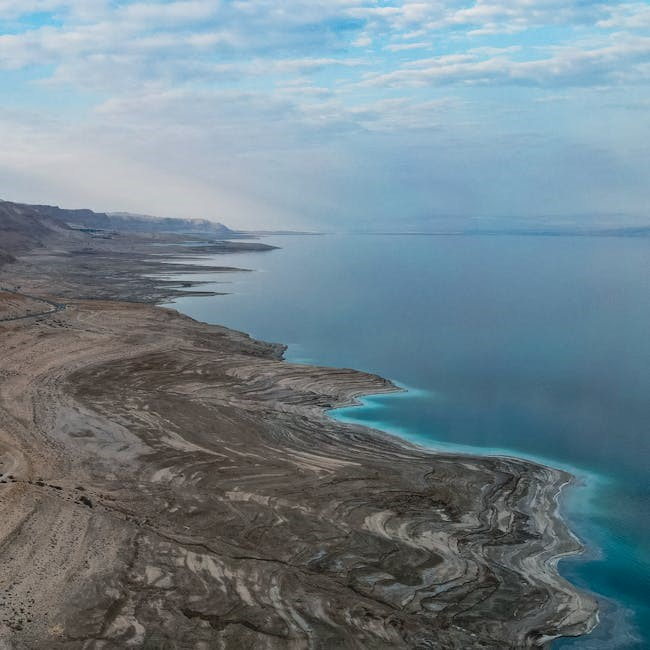The Dead Sea Scrolls, discovered near Qumran, offer ancient Hebrew, Aramaic, and Greek texts․ Their English translations, notably by Geza Vermes, provide insights into early Judaism and Christianity, now accessible in digital formats like PDF․

1․1 Historical Significance of the Dead Sea Scrolls
The Dead Sea Scrolls are among the most significant archaeological discoveries of the 20th century․ Discovered between 1947 and 1956 in the Qumran Caves near the Dead Sea, these ancient texts include biblical manuscripts, apocryphal works, and sectarian writings․ Dating back to the 2nd century BCE to the 1st century CE, they provide unparalleled insights into the textual history of the Hebrew Bible, early Jewish thought, and the origins of Christianity․ The scrolls reveal diverse religious and cultural practices of the time, challenging and enriching modern understanding of ancient Judaism․ Their translation into English, as seen in works by scholars like Geza Vermes, has made these treasures accessible to a global audience, fostering religious and historical scholarship․
1․2 Overview of the Discovery and Preservation

The Dead Sea Scrolls were first discovered in 1947 by Bedouin shepherds in Qumran Cave 1 near the Dead Sea․ The initial findings included seven scrolls, later expanding to over 900 manuscripts across 11 caves․ These scrolls were preserved for millennia due to the arid desert climate, with many fragments stored in clay jars․ The discovery sparked extensive explorations led by archaeologists and scholars, including the École Biblique and the Palestine Archaeological Museum․ Preservation efforts involved careful unrolling, cataloging, and translation, with modern techniques like infrared imaging aiding in deciphering faded texts․ Digital initiatives now provide global access to these ancient writings, ensuring their longevity and scholarly study․ This discovery remains one of the most significant in biblical archaeology, offering insights into ancient Judaism and early Christianity․

The Discovery and Exploration of the Scrolls
The Dead Sea Scrolls were first discovered in 1947 by Bedouin shepherds near Qumran․ Subsequent explorations revealed over 900 manuscripts, including biblical texts and apocryphal works․
2․1 The 1947 Discovery in Qumran
In 1947, Bedouin shepherds near Qumran in the Judaean Desert stumbled upon a hidden cave containing ancient scrolls․ Their discovery, known as the Dead Sea Scrolls, included texts like the Great Isaiah Scroll and the Manual of Discipline, which are now available in English translations․ These scrolls, written in Hebrew, Aramaic, and Greek, were preserved for centuries in jars․ The initial find sparked widespread interest, leading to further explorations and the identification of additional caves․ This discovery revolutionized biblical studies and early Jewish history․ Today, these texts are accessible in PDF formats, offering insights into ancient religious practices and scriptural interpretations․

2․2 Subsequent Explorations and Finds
Following the 1947 discovery, systematic archaeological excavations between 1947 and 1956 uncovered additional caves near Qumran, revealing over 800 scrolls․ These included biblical texts, apocryphal works, and sectarian writings․ Scholars like Geza Vermes and Florentino García Martínez later translated these texts into English, making them accessible․ The scrolls, written in Hebrew, Aramaic, and Greek, provided unparalleled insights into Jewish thought and early Christianity․ Their translations, now available in PDF formats, remain crucial for historical and religious studies, offering a window into ancient traditions and scriptural interpretations․
The Translation Process of the Dead Sea Scrolls
The translation of the Dead Sea Scrolls involved meticulous scholarly efforts․ Early translators faced challenges due to fragmented texts, requiring advanced linguistic and historical analysis․ Modern scholarship utilized digital tools and collaborative efforts to ensure accuracy, making translations widely accessible in formats like PDF․ These translations have illuminated the scrolls’ significance for biblical studies and early religious history․
3․1 Early Translation Efforts and Challenges
The early translation of the Dead Sea Scrolls was a monumental task marked by significant challenges․ Initially, scholars like Geza Vermes and Florentino García Martínez pioneered the efforts, facing obstacles such as fragmented texts, unknown languages, and limited technological resources․ The scrolls, written in Hebrew, Aramaic, and Greek, required meticulous analysis to decipher their meaning․ Many texts were incomplete, with missing sections that made interpretation difficult․ Additionally, the sensitive nature of the material, often on fragile parchment, demanded careful handling․ Despite these hurdles, early translators laid the foundation for understanding the scrolls’ historical and religious significance․ Their work, now available in digital formats like PDF, has become indispensable for modern scholarship and public access․
3․2 Modern Translations and Scholarship
Modern translations of the Dead Sea Scrolls have significantly advanced our understanding, leveraging technological advancements and collaborative scholarship․ Digital tools now enable precise analysis of fragmented texts, while updated editions incorporate newly discovered fragments․ Scholars like Geza Vermes and Florentino García Martínez have produced authoritative English translations, ensuring accessibility for both academics and the public․ Digital formats, such as PDFs, have made these translations widely available, facilitating global research․ Modern scholarship emphasizes interdisciplinary approaches, integrating historical, linguistic, and archaeological insights․ These efforts have refined interpretations of key texts, offering deeper insights into the scrolls’ historical and religious contexts․ The ongoing refinement of translations ensures the scrolls remain a vital resource for studying early Judaism and Christianity․
Key Texts and Their English Translations

The Dead Sea Scrolls include iconic texts like the Great Isaiah Scroll and the Manual of Discipline․ These have been translated into English, offering insights into ancient Jewish practices and beliefs; PDF versions of these translations are widely accessible, enabling scholars and enthusiasts to explore the scrolls’ significance in understanding early Judaism and Christianity․
4․1 The Great Isaiah Scroll (1QIsa)
The Great Isaiah Scroll, also known as 1QIsa, is one of the most well-preserved biblical scrolls among the Dead Sea Scrolls․ It contains the entire text of the Book of Isaiah, offering a unique glimpse into the textual history of the Hebrew Bible․ The scroll is remarkable for its completeness, with only a few minor damaged sections․ Its English translation reveals striking similarities to modern biblical texts, showcasing the textual stability of Isaiah over centuries; The scroll’s significance extends beyond its content, as it provides scholars with valuable insights into ancient scribal practices and the transmission of sacred texts․ PDF versions of the Great Isaiah Scroll, including its English translation, are available online, allowing global access to this ancient manuscript․
4․2 The Manual of Discipline (Community Rule)
The Manual of Discipline, also known as the Community Rule, is a foundational text among the Dead Sea Scrolls․ It outlines the rules, beliefs, and practices of the Qumran community, providing insights into their organizational structure and religious life․ The text emphasizes communal living, ethical conduct, and ritual purity, offering a detailed code of behavior for members․ Its English translation reveals a highly structured society dedicated to spiritual discipline and adherence to Jewish law․ The Manual of Discipline is particularly significant for understanding the social and religious dynamics of the Qumran sect․ PDF versions of the text, including its English translation, are widely available, making this ancient manuscript accessible to scholars and enthusiasts alike for deeper study and reflection․

The Dead Sea Scrolls in PDF Format
The Dead Sea Scrolls are now widely available in PDF format, offering complete English translations of biblical and non-biblical texts․ Digital preservation ensures accessibility for scholars and the public․
5․1 Availability of Translations in Digital Formats
The Dead Sea Scrolls are now widely accessible in digital formats, particularly as PDFs, offering complete English translations of both biblical and non-biblical texts․ These digital versions, such as The Complete Dead Sea Scrolls in English by Geza Vermes, provide scholars and enthusiasts with searchable, portable access to ancient manuscripts․ Platforms like PDFDrive and the Internet Archive host these resources, ensuring global accessibility․ Digital preservation has revolutionized the study of these texts, allowing for easier cross-referencing and analysis․ Additionally, online repositories often include high-resolution scans of the original scrolls, enabling comparative studies between the Hebrew, Aramaic, or Greek sources and their English translations․ This digital availability has democratized access to these invaluable historical documents, fostering deeper understanding and research worldwide․

5․2 Popular PDF Resources and Their Contents
Popular PDF resources like The Complete Dead Sea Scrolls in English by Geza Vermes offer comprehensive translations of biblical and non-biblical texts․ These PDFs include works such as the Great Isaiah Scroll, the Manual of Discipline, and apocalyptic texts like the War Scroll․ They also feature introductory notes, historical context, and scholarly insights, making them invaluable for both researchers and general readers․ Platforms like PDFDrive and the Internet Archive provide free access to these documents, while publications from Brill and Penguin Books offer meticulously translated editions․ These resources are enriched with cross-references and comparative analyses, enhancing the study of ancient Judaism and early Christianity․ Their digital format ensures portability and ease of access, making them essential tools for modern scholarship and personal exploration․
The Biblical and Non-Biblical Texts
The Dead Sea Scrolls include biblical texts like Isaiah and non-biblical works such as the Manual of Discipline, offering insights into ancient Jewish practices and beliefs․
6․1 Biblical Texts Found Among the Scrolls
Biblical texts among the Dead Sea Scrolls include Isaiah, Psalms, and Exodus, with the Great Isaiah Scroll being a notable example․ These texts, now translated into English, reveal remarkable consistency with modern Bibles, despite minor variations․ The scrolls provide the oldest known copies of many biblical books, offering scholars unique insights into textual evolution and ancient interpretation․ Their preservation and translation have significantly enriched biblical studies, confirming the reliability of the Hebrew Bible while highlighting the diversity of early Jewish scripture traditions․ Digital versions, such as PDFs, make these texts accessible to global audiences, facilitating deeper exploration of their historical and religious significance․
6․2 Non-Biblical Texts and Their Significance
Non-biblical texts among the Dead Sea Scrolls, such as the Manual of Discipline and apocalyptic works, provide unique insights into the beliefs and practices of the Qumran community․ These texts, now translated into English, reveal a fascinating blend of theology, liturgy, and communal rules․ The scrolls also contain previously unknown works, such as the Copper Scroll and Enochic literature, which offer perspectives on Jewish mysticism and eschatology․ Their significance lies in their contribution to understanding early Jewish thought and the cultural context of nascent Christianity․ Digital resources, including PDFs, have made these texts widely accessible, enabling scholars and enthusiasts to explore their rich historical and religious dimensions․ These non-biblical writings remain a vital part of the Dead Sea Scrolls’ enduring legacy․
The Contribution of Scholars
Geza Vermes and Florentino García Martínez are key scholars whose translations of the Dead Sea Scrolls have made these ancient texts accessible to a broader audience․
7․1 Geza Vermes and His Translations
Geza Vermes, a renowned scholar, has significantly contributed to the study of the Dead Sea Scrolls through his authoritative English translations․ His work, first published in 1962, has become a standard reference, offering insights into the texts’ historical and religious significance․ Vermes’ translations include previously unpublished manuscripts, providing a comprehensive understanding of the Qumran community’s beliefs and practices․ His seventh edition, updated with new research, remains a vital resource for scholars and enthusiasts alike․ Vermes’ efforts have made the scrolls accessible to a broader audience, bridging ancient texts with modern understanding, and illuminating the roots of early Judaism and Christianity․
7․2 Florentino García Martínez and His Work
Florentino García Martínez, a distinguished scholar, has significantly enriched the field of Dead Sea Scrolls research through his meticulous translations and analyses․ His work, particularly in collaboration with E․J․ Brill, has produced comprehensive editions of the Qumran texts in English․ Martínez’s translations emphasize accuracy and context, providing deeper insights into the theological and cultural nuances of the scrolls․ His contributions have been instrumental in making these ancient texts accessible to both scholars and the general public․ Martínez’s work continues to be a cornerstone in the study of early Judaism and the historical context of Christianity, offering a fresh perspective on the significance of the Dead Sea Scrolls․

The Impact on Religious and Historical Studies
The Dead Sea Scrolls revolutionized understanding of biblical texts and early religious movements․ They challenged traditional interpretations and offered fresh insights into scriptural evolution and historical practices․
8․1 Influence on Biblical Studies
The Dead Sea Scrolls significantly impacted biblical studies by providing ancient manuscripts that predate previously known texts by centuries․ These scrolls, such as the Great Isaiah Scroll, revealed remarkable consistency with modern Bibles, while also offering variations that sparked debates on textual accuracy․ For instance, the scrolls’ versions of Isaiah and other biblical books showed slight differences from the Masoretic Text, challenging scholars to reassess the evolution of Scripture․ Additionally, non-biblical texts like the Manual of Discipline shed light on the theological and communal practices of the Qumran community․ These findings enriched biblical scholarship, offering new perspectives on scriptural formation and interpretation, while also reinforcing the reliability of the Hebrew Bible․ The availability of these texts in English translations, particularly in PDF formats, has further democratized access to these critical resources for both scholars and laypeople․
8․2 Insights into Early Judaism and Christianity
The Dead Sea Scrolls offer unparalleled insights into early Judaism and Christianity, revealing the theological and cultural milieu of the Qumran community․ Non-biblical texts like the Manual of Discipline and the Copper Scroll provide details about communal practices, messianic expectations, and apocalyptic beliefs․ These texts, now available in English translations, highlight the diversity of Jewish thought before the destruction of the Second Temple․ They also show connections to early Christian movements, such as shared motifs in the Psalms Scroll and themes of communal living․ The scrolls’ translation into English, particularly in PDF formats, has made these insights accessible, fostering a deeper understanding of the roots of both Judaism and Christianity․ This accessibility continues to inspire scholarly and public interest in these ancient texts․

The Dead Sea Scrolls and Digital Technology
Digital technology has revolutionized access to the Dead Sea Scrolls, with PDF translations and online resources enabling global exploration of these ancient texts․
9․1 Digital Preservation and Accessibility
Digital preservation of the Dead Sea Scrolls ensures their longevity and accessibility․ High-resolution scans and translations are now available online, allowing scholars and the public to explore these ancient texts․ PDF formats of translations, such as Geza Vermes’ work, provide a convenient way to access the scrolls․ Digital platforms have transformed how these fragile documents are studied, enabling global collaboration and research․ This technological advancement has democratized access, fostering a deeper understanding of the scrolls’ historical and religious significance․ The integration of digital tools has also enhanced the preservation efforts, safeguarding the scrolls for future generations․
9․2 Online Resources and Translations
Online resources have revolutionized access to the Dead Sea Scrolls․ Websites offer downloadable PDFs of English translations, such as Geza Vermes’ and Florentino García Martínez’ works․ These resources include complete editions and specific texts like the Great Isaiah Scroll․ Digital libraries provide searchable databases, enabling scholars to cross-reference translations with original texts․ Additionally, platforms like the Israel Antiquities Authority’s Leon Levy Digital Archive offer high-resolution images alongside translations․ These online tools facilitate in-depth study and comparison, making the scrolls more accessible to both researchers and enthusiasts․ The availability of these resources ensures that the Dead Sea Scrolls remain a vital area of study in biblical and historical research․
The Dead Sea Scrolls remain a cornerstone in understanding ancient Judaism and Christianity․ Their digital availability ensures ongoing research and accessibility, fostering future scholarly advancements and public engagement․
10․1 The Ongoing Significance of the Scrolls
The Dead Sea Scrolls hold immense historical and religious value, offering insights into ancient Jewish practices and early Christian origins․ Their translations, such as Geza Vermes’ works, have made these texts accessible to global audiences․ The scrolls’ digital availability in formats like PDF has further enhanced their reach, allowing scholars and enthusiasts to explore their contents effortlessly․ This accessibility ensures that the scrolls remain a vital resource for understanding the evolution of religious thought and textual interpretation․ As technology advances, their digital preservation guarantees that future generations will continue to study and appreciate these ancient manuscripts, fostering ongoing scholarly dialogue and public engagement with history․
10․2 Future Directions in Translation and Study
Future research on the Dead Sea Scrolls will likely focus on advancing digital tools for translation and analysis․ AI technologies could enhance the accuracy of fragment reconstructions and linguistic interpretations․ Collaborative efforts among global scholars will refine translations and explore new textual insights․ Public engagement will also grow, with PDF resources and online platforms making the scrolls more accessible․ Education initiatives will integrate these translations into curricula, fostering deeper understanding among diverse audiences․ By leveraging modern technology and interdisciplinary approaches, the study of the Dead Sea Scrolls will continue to illuminate ancient history and religious traditions, ensuring their relevance for future generations․